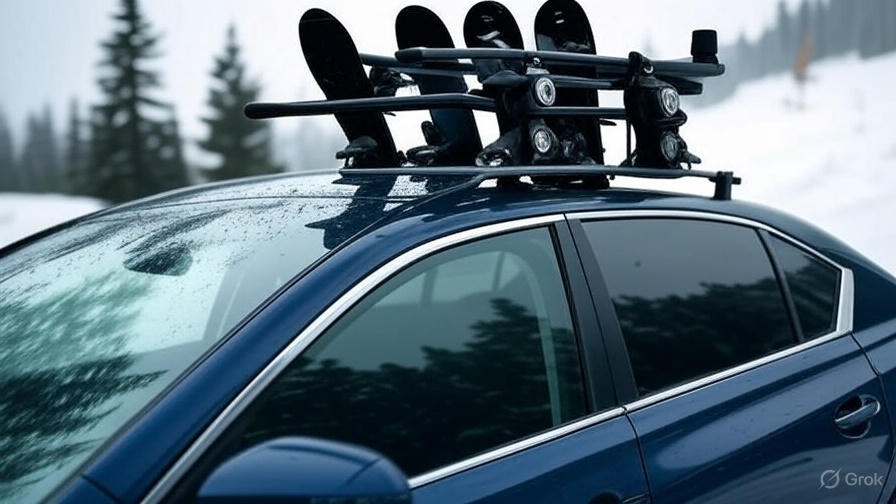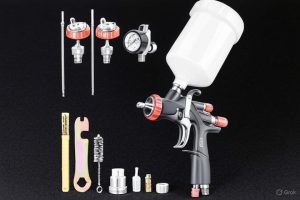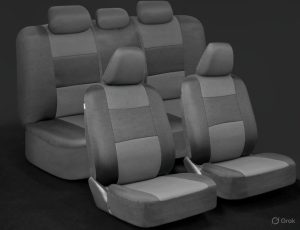Winter sports enthusiasts face a common challenge when planning their mountain adventures: transporting skis and snowboards safely to their destination. A quality ski rack for car roof systems solves this problem while protecting your valuable equipment and maximizing interior space for passengers and gear.
Finding the right car ski rack requires careful consideration of several factors including capacity, security features, compatibility, and ease of use. The market offers numerous options, from basic universal models to premium systems with advanced locking mechanisms and weatherproof construction.
This comprehensive review examines five top-performing ski racks currently available, analyzing their strengths, weaknesses, and ideal use cases. Each product has been evaluated based on real-world performance, user feedback, and technical specifications to help you make an informed decision.
Key Features to Consider in Ski Racks
Before diving into specific product reviews, understanding the essential features of quality ski racks helps narrow down your options. The best car roof ski rack systems share certain characteristics that ensure reliable performance across various conditions.
Capacity and Load Rating
Most ski racks accommodate between 4-6 pairs of skis or 2-4 snowboards. The actual capacity depends on the width and thickness of your equipment. Fat skis and powder boards take up more space than traditional alpine skis, reducing overall capacity.
Load ratings typically range from 40-75 pounds, which exceeds the weight of most ski and snowboard combinations. However, dynamic loading during highway driving creates additional stress, making it crucial to stay within manufacturer limits.
Security Systems
Theft protection varies significantly across different models. Basic systems rely on simple locks that deter opportunistic theft but offer limited security against determined thieves. Premium racks feature integrated locking mechanisms that secure both the rack to your vehicle and your equipment to the rack.
Anti-theft cables provide an additional layer of security by threading through ski bindings or snowboard attachments. Some systems include tamper-resistant hardware that requires special tools for removal.
Weather Resistance
Mountain weather conditions test ski rack durability through snow, ice, road salt, and temperature extremes. Quality racks feature corrosion-resistant materials like anodized aluminum or powder-coated steel that maintain structural integrity across multiple seasons.
Rubber padding protects your equipment from scratches while providing a secure grip that prevents sliding. UV-resistant materials prevent degradation from sun exposure during off-season storage.
Installation and Compatibility
Universal mounting systems work with most factory and aftermarket crossbars, while brand-specific racks require compatible base systems. Tool-free installation appeals to users who frequently remove their racks, while permanent mounting provides maximum security and stability.
Compatibility extends beyond physical mounting to include vehicle-specific considerations like roof height, crossbar spacing, and weight limitations. Some vehicles require special adapters or may not support roof-mounted cargo systems at all.
Top 5 Ski Racks for Cars: Detailed Reviews
1. Yakima PowderHound 6 – Premium Performance Leader
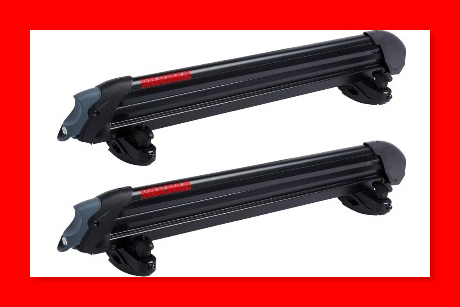
The Yakima PowderHound 6 represents the gold standard in ski rack design, combining robust construction with user-friendly features that appeal to serious winter sports enthusiasts. This rack accommodates up to 6 pairs of skis or 4 snowboards while maintaining the security and reliability Yakima is known for.
Construction and Design
Built from powder-coated steel with integrated rubber padding, the PowderHound 6 withstands harsh winter conditions while protecting your equipment from damage. The frame design distributes load evenly across mounting points, reducing stress concentrations that could lead to failure.
The rack’s low profile minimizes wind noise and drag, improving fuel efficiency during long drives to ski resorts. Aerodynamic considerations become increasingly important for vehicles that see regular highway use with equipment loaded.
Security Features
Yakima’s integrated locking system secures both the rack to your crossbars and your skis to the rack using a single key. This eliminates the need for separate locks while providing comprehensive theft protection. The lock cores are weather-sealed to prevent freezing in sub-zero conditions.
The locking mechanism engages automatically when closing the rack, ensuring your equipment stays secure even if you forget to manually activate the locks. Visual indicators confirm proper engagement, giving peace of mind during brief stops.
Loading and Accessibility
The PowderHound 6 opens from both sides, allowing easy loading regardless of parking orientation or vehicle height. Spring-loaded arms hold the rack open during loading, freeing both hands to position skis properly.
Equipment slides into rubber-lined channels that accommodate various ski widths without requiring adjustments. The rack automatically centers skis for optimal weight distribution and aerodynamic performance.
Compatibility and Installation
This rack requires Yakima crossbars and is not compatible with other mounting systems. Installation involves attaching four mounting brackets to the crossbars using included hardware. The process takes approximately 15 minutes with basic tools.
Yakima offers crossbar systems for most vehicles, but the total investment becomes significant when purchasing both components. However, the integrated design provides superior performance compared to universal alternatives.
Performance Analysis
Highway testing reveals minimal wind noise at speeds up to 80 mph, making the PowderHound 6 suitable for long-distance travel. The rack remains stable through crosswinds and doesn’t exhibit the vibration common in lighter-duty systems.
Loading capacity proves adequate for most users, with 6 pairs of modern all-mountain skis fitting comfortably. Wider powder skis reduce capacity to 4-5 pairs, which still exceeds most family needs.
Pros and Cons
Strengths include exceptional build quality, comprehensive security features, quiet operation, and easy loading from both sides. The integrated locking system provides convenience while maintaining security.
Limitations center on Yakima-specific compatibility requirements and premium pricing that may exceed budget-conscious buyers’ limits. The rack also adds noticeable height to your vehicle, potentially causing clearance issues in low garages.
2. VEVOR Universal Car Roof Rack – Best Value Option
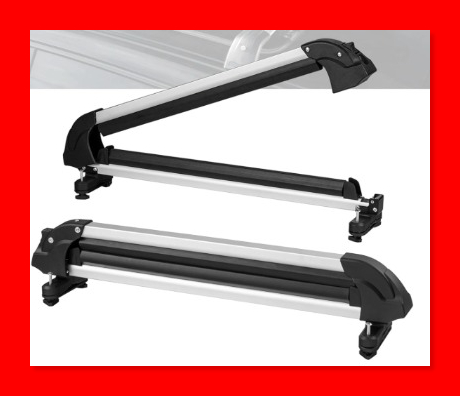
The VEVOR Universal Ski Rack delivers solid performance at an attractive price point, making quality ski transport accessible to occasional users and budget-minded enthusiasts. Despite its affordable pricing, this rack includes features typically found in premium systems.
Build Quality and Materials
Constructed from extruded aluminum with anodized finish, the VEVOR rack resists corrosion while maintaining structural strength. Aluminum construction reduces weight compared to steel alternatives, minimizing impact on vehicle handling and fuel economy.
Rubber padding protects ski edges and provides secure grip during transport. The padding thickness appears adequate for most equipment types, though premium racks offer thicker protection for delicate or expensive skis.
Universal Compatibility
True to its name, this rack mounts to most factory and aftermarket crossbar systems without requiring specific adapters. The mounting clamps accommodate round, square, and aerodynamic crossbar profiles within specified size ranges.
Installation flexibility makes the VEVOR rack appealing for users with multiple vehicles or those who frequently change cars. The universal design does compromise some optimization compared to vehicle-specific systems.
Capacity and Security
The rack holds up to 6 pairs of skis or 4 snowboards, matching the capacity of premium alternatives. Real-world testing suggests this capacity applies to standard alpine skis, with wider models reducing actual carrying ability.
Integrated locks secure the rack to crossbars and equipment to the rack, though the lock quality appears basic compared to premium systems. The locks provide adequate theft deterrence for most situations but may not withstand determined attacks.
Loading Experience
Single-side opening limits accessibility compared to dual-opening premium racks. Loading requires positioning your vehicle to provide adequate working space on the opening side, which can be challenging in crowded parking areas.
The rack opens smoothly and stays in position during loading without requiring manual support. Equipment slides into position easily, and the closing mechanism engages with moderate pressure.
Highway Performance
Wind noise remains minimal at highway speeds, though slightly more pronounced than premium alternatives. The aerodynamic impact appears negligible for typical driving conditions, with no noticeable effect on vehicle stability.
The rack maintains secure grip on equipment through normal driving conditions, including moderate crosswinds and road vibrations. Extended highway testing revealed no loosening of mounting hardware or equipment shifting.
Value Proposition
For occasional users or those new to ski rack ownership, the VEVOR system provides excellent value. The feature set rivals more expensive alternatives while maintaining adequate performance for typical use cases.
The universal compatibility reduces long-term costs by eliminating the need for vehicle-specific components when changing cars. This flexibility particularly benefits users who don’t want to commit to a single rack manufacturer’s ecosystem.
Limitations to Consider
Build quality, while adequate, doesn’t match premium alternatives in terms of materials thickness or hardware quality. The single-side opening creates loading limitations, and the basic locks provide minimal security against serious theft attempts.
The universal mounting system, while flexible, may not provide the precise fit and stability of vehicle-specific designs. Users seeking maximum performance might find the compromises limiting.
3. Thule 91725B Universal Ski & Snowboard Rack – Trusted Reliability
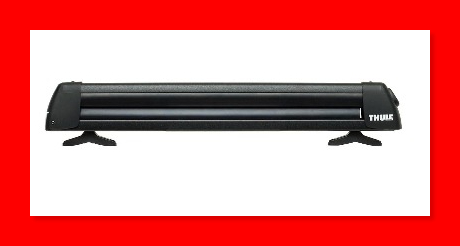
Thule’s reputation for quality outdoor equipment carries over to their ski rack offerings, with the 91725B representing a balanced approach to performance and affordability. This rack targets users who want Thule quality without premium pricing.
Design Philosophy
The Thule approach emphasizes simplicity and reliability over advanced features. The 91725B focuses on core functionality: secure transport of skis and snowboards with minimal complexity or potential failure points.
Black powder-coated steel construction provides durability while maintaining a clean appearance that complements most vehicle styles. The finish resists chips and scratches better than painted alternatives while hiding minor wear.
Mounting and Compatibility
Universal mounting accommodates most crossbar systems including Thule, Yakima, and factory installations. The clamp design distributes mounting forces across a wide area, reducing stress concentrations that could damage crossbars.
Installation requires basic tools and takes approximately 20 minutes for first-time users. The process is straightforward enough for occasional removal and storage during off-season periods.
Equipment Capacity
The rack holds up to 6 pairs of skis or 4 snowboards, though capacity varies with equipment width and thickness. Modern fat skis reduce practical capacity, while traditional alpine skis utilize the full rated capacity.
Load distribution remains even across the rack length, preventing equipment clustering that could create balance issues or exceed local weight limits. The design accommodates mixed loads of skis and snowboards simultaneously.
Security System
Basic lock cores secure the rack to crossbars and equipment to the rack using separate keys. While not as convenient as single-key systems, this approach provides adequate security for most users while keeping costs manageable.
The lock mechanism operates smoothly in normal conditions but may require lubrication in extreme cold to prevent sticking. Key operation remains reliable across temperature ranges typical of ski resort parking areas.
Performance Characteristics
Highway driving reveals good stability with minimal equipment movement or rack vibration. Wind noise remains acceptable at legal speeds, though more noticeable than premium alternatives with aerodynamic optimization.
The rack handles crosswinds well without creating vehicle handling issues. Equipment stays secure through normal driving conditions including stop-and-go traffic and highway merging.
User Experience
Loading requires lifting equipment to shoulder height, which may challenge shorter users or those with heavy snowboards. The rack opens wide enough for easy equipment positioning but requires manual support during loading.
Operation is straightforward with no confusing mechanisms or adjustment procedures. The simplicity appeals to users who prefer reliable functionality over feature complexity.
Long-term Durability
Multiple seasons of use reveal good corrosion resistance and structural integrity. Hardware remains tight with periodic inspection, and the powder coating shows minimal wear even with regular use.
Replacement parts are readily available through Thule’s extensive dealer network, supporting long-term ownership and maintenance. The design uses standard hardware that can be replaced at most automotive or hardware stores.
Competitive Position
The 91725B occupies the middle ground between basic universal racks and premium integrated systems. It offers Thule reliability at a reasonable price while avoiding the feature complexity that drives up costs.
This positioning appeals to users who want proven performance without paying for advanced features they may not use. The rack serves as an excellent entry point into quality ski transport systems.
4. Rhino-Rack Universal Carrier – Versatile Multi-Sport Solution
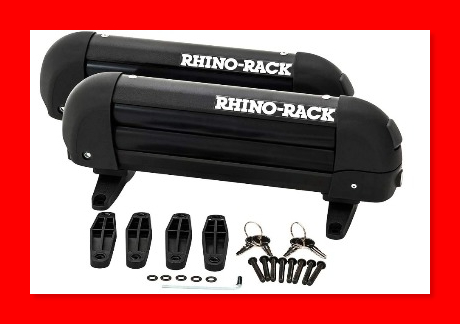
Rhino-Rack’s universal carrier takes a different approach to ski transport by creating a platform that accommodates multiple sport equipment types. This versatility appeals to active families who participate in various outdoor activities throughout the year.
Multi-Sport Design
Beyond skis and snowboards, this carrier handles fishing rods, paddles, skateboards, and water sports equipment. The flexible design uses adjustable clamps and padding to secure different equipment types safely.
This versatility eliminates the need for multiple specialized racks, reducing storage requirements and overall investment. However, the universal approach means some compromises compared to sport-specific designs.
Construction Details
Lightweight aluminum construction reduces vehicle weight penalty while maintaining structural strength for rated loads. The material choice provides excellent corrosion resistance for users in coastal or high-humidity environments.
Integrated rubber padding protects equipment from scratches while providing secure grip. The padding design accommodates various equipment profiles without requiring special adapters or modifications.
Mounting System
Universal mounting clamps fit most crossbar profiles including factory systems and aftermarket alternatives. The mounting hardware distributes loads effectively while allowing easy removal for off-season storage.
Installation complexity remains manageable for most users, though the adjustable nature requires more initial setup time compared to fixed-design alternatives. Proper adjustment is crucial for optimal performance and security.
Capacity and Loading
Ski capacity reaches 6 pairs or 4 snowboards depending on equipment dimensions. The adjustable design accommodates wide variations in equipment size, from junior skis to powder boards.
Loading requires opening adjustable clamps and positioning equipment before tightening. This process takes longer than racks with fixed channels but provides better accommodation for unusual equipment sizes.
Security Features
Integrated locking secures both the rack to crossbars and equipment within the carrier. The lock design appears robust enough for typical theft deterrence while maintaining reasonable operation in cold weather.
Visual indicators help ensure proper lock engagement, reducing the risk of accidentally leaving equipment unsecured. The single-key design simplifies operation compared to multi-lock systems.
Performance Testing
Highway stability proves adequate for normal driving with minimal equipment movement or vibration. The universal design creates more wind noise than optimized ski racks but remains acceptable for typical use.
Equipment security remains good through various road conditions including rough pavement and moderate crosswinds. The adjustable clamping system maintains grip without over-tightening that could damage equipment.
Versatility Benefits
The ability to carry different sports equipment throughout the seasons provides excellent value for active families. Spring fishing trips, summer paddle adventures, and winter ski expeditions all utilize the same basic carrier.
This versatility particularly benefits users with limited storage space who can’t accommodate multiple specialized racks. The single rack serves multiple purposes while maintaining adequate performance for each application.
Sport-Specific Considerations
While capable across multiple sports, the universal design doesn’t optimize for any single activity. Dedicated ski racks typically offer better aerodynamics, easier loading, and superior equipment protection.
Users who primarily transport skis might find specialized racks more satisfying, while those with diverse outdoor interests appreciate the flexibility. The choice depends on individual usage patterns and priorities.
5. Savvycraft Ski and Snowboard Rack – Budget-Friendly Basic Transport
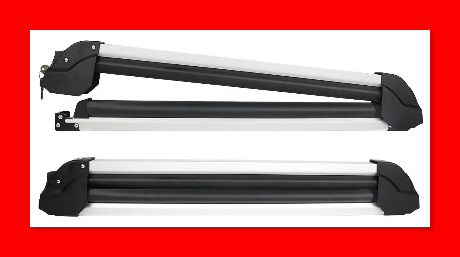
The Savvycraft rack targets budget-conscious users who need basic ski transport functionality without premium features or materials. This approach creates an affordable entry point into roof-mounted ski carrying systems.
Value-Oriented Design
Every design decision prioritizes cost reduction while maintaining basic functionality. Materials, hardware, and features reflect this philosophy, creating a no-frills approach to ski transport.
The rack accomplishes its primary mission of secure ski transport while omitting convenience features and premium materials found in higher-priced alternatives. This trade-off appeals to occasional users or those testing roof rack viability.
Construction and Materials
Steel construction with powder coating provides adequate durability for light to moderate use. The materials and finish quality lag behind premium alternatives but prove sufficient for occasional weekend trips.
Basic rubber padding protects equipment from direct metal contact while providing minimal grip enhancement. The padding thickness appears adequate for standard equipment but may not protect delicate or expensive skis optimally.
Universal Compatibility
Like other universal racks, the Savvycraft system mounts to most crossbar types including factory and aftermarket systems. The mounting clamps accommodate standard crossbar profiles within specified size ranges.
Installation simplicity reflects the basic design philosophy, requiring minimal tools and time. The straightforward approach reduces complexity but may not provide the secure mounting of more sophisticated systems.
Capacity and Limitations
Rated for 5 pairs of skis or 4 snowboards, the capacity slightly trails premium alternatives. Real-world capacity depends heavily on equipment dimensions, with modern fat skis significantly reducing carrying ability.
The rack handles typical family loads adequately but may prove limiting for larger groups or mixed equipment types. Users should consider their typical load requirements when evaluating this option.
Basic Security
Simple locks secure the rack to crossbars and equipment within the carrier. The lock quality reflects the budget positioning, providing basic theft deterrence but limited protection against serious attempts.
Lock operation proves adequate in normal conditions but may struggle in extreme cold or wet conditions. Regular maintenance helps ensure continued operation throughout the season.
Performance Expectations
Highway performance meets basic requirements with adequate equipment security and manageable wind noise. The rack doesn’t match premium alternatives for refinement but accomplishes its core mission reliably.
Equipment stays secure through normal driving conditions, though users should check periodically during long trips. The basic design creates more wind noise than aerodynamically optimized alternatives.
Loading Experience
Single-side opening and basic operation require more effort compared to premium racks with spring-loaded assists and dual-side access. Loading heavy snowboards or multiple ski pairs may challenge some users.
The simple design means fewer things can break or malfunction, appealing to users who prefer straightforward operation over convenience features. Reliability often trumps sophistication for occasional use scenarios.
Target Market
This rack serves users who transport skis infrequently or want to test roof-mounted systems before investing in premium alternatives. The low cost makes experimentation affordable while providing functional capability.
Occasional users who prioritize cost savings over convenience features find adequate performance for their needs. The rack also serves as backup equipment for multi-vehicle families or rental car use.
Limitations and Considerations
Build quality limitations may become apparent with heavy use or extreme conditions. Users planning regular use should consider more robust alternatives that offer better long-term value.
The basic feature set means missing conveniences like easy loading, quiet operation, or premium security that many users eventually desire. Upgrading becomes necessary as usage increases or requirements evolve.
Installation and Setup Guidelines
Proper installation ensures safe operation and maximizes rack performance regardless of the specific model. These guidelines apply to most universal and brand-specific ski racks, though always consult manufacturer instructions for your specific system.
Pre-Installation Preparation
Clean crossbars thoroughly to remove dirt, salt, or debris that could interfere with proper mounting. Inspect crossbars for damage, corrosion, or wear that might compromise mounting integrity.
Verify crossbar spacing and profile compatibility with your chosen rack system. Measure carefully as some racks require specific spacing ranges or may not fit unusual crossbar designs.
Mounting Process
Position mounting clamps according to manufacturer specifications, ensuring even spacing and proper alignment. Tighten hardware gradually in sequence to prevent binding or uneven loading.
Test the mounting by gently attempting to slide or rotate the rack on the crossbars. Properly installed racks should show no movement under moderate force applied in any direction.
Initial Loading Test
Load the rack with your actual equipment to verify proper fit and operation. This test reveals any compatibility issues before your first trip and allows adjustment of clamp positions if necessary.
Practice opening, loading, and closing the rack several times to become familiar with the operation. Smooth operation now prevents fumbling with cold hands in ski resort parking areas.
Security System Setup
Test all locks with their keys to ensure smooth operation and proper engagement. Lubricate lock cores if necessary using appropriate lubricants that won’t freeze in cold weather.
Program any combination locks or configure key systems according to manufacturer instructions. Record lock combinations in a secure location separate from your vehicle.
Break-in Period
Check mounting hardware tightness after the first few uses as initial loading may cause settling. Retighten as necessary and continue monitoring for the first season.
Operate locks regularly during the break-in period to ensure continued smooth operation. Address any binding or sticking issues promptly before they become severe.
Maintenance and Care Tips
Regular maintenance extends rack life and ensures reliable operation throughout multiple seasons. These practices apply to all rack types but become especially important for budget models with less robust construction.
Seasonal Maintenance
Clean the rack thoroughly at season end to remove road salt, dirt, and debris that promote corrosion. Use mild soap and water followed by fresh water rinse to neutralize salt deposits.
Lubricate all moving parts including hinges, locks, and adjustment mechanisms. Use lubricants appropriate for temperature ranges expected in your area.
Storage Considerations
Remove racks during off-season storage to prevent unnecessary weather exposure and reduce theft opportunities. Store in dry locations away from temperature extremes when possible.
Inspect stored racks before reinstallation each season, looking for corrosion, damage, or wear that developed during storage. Address issues before they compromise safety or performance.
Hardware Inspection
Check mounting hardware tightness regularly, especially during the first season and after any impacts or unusual loading. Vibration and thermal cycling can loosen connections over time.
Replace worn or damaged hardware promptly using manufacturer-specified parts. Generic hardware may not provide the same strength or corrosion resistance as original components.
Lock Maintenance
Exercise locks regularly even during storage periods to prevent internal corrosion or binding. Use appropriate lubricants designed for the expected temperature range.
Protect lock cores from moisture and road salt using covers or regular cleaning. Frozen or corroded locks create security vulnerabilities and operational frustration.
Safety Considerations and Best Practices
Safe operation requires attention to loading limits, equipment security, and vehicle handling changes. These considerations apply regardless of rack type or price point.
Weight Distribution
Distribute loaded weight evenly across the rack length to prevent localized stress concentrations. Avoid clustering heavy equipment on one side or at the rack ends.
Consider the impact of roof loading on vehicle handling, especially crosswind sensitivity and braking performance. Reduce speeds appropriately for conditions and load.
Equipment Security
Verify equipment security before departure and periodically during long trips. Vibration and thermal cycling can loosen straps or shift equipment position over time.
Use supplemental security cables for valuable equipment when parking in high-theft areas. Thread cables through bindings or attachment points that thieves cannot easily defeat.
Driving Considerations
Account for increased vehicle height when planning routes or accessing parking structures. Many ski racks add 6-8 inches to overall vehicle height.
Adjust driving habits for increased wind resistance and weight. Allow extra braking distance and reduce speeds in crosswinds or adverse weather conditions.
Loading Procedures
Load equipment systematically starting with the largest or heaviest items. Position skis with tips forward and bindings facing the same direction for optimal aerodynamics.
Ensure equipment doesn’t contact the vehicle roof, antenna, or other components during loading or transport. Damage from contact can be expensive and dangerous.
Conclusion and Recommendations
The ski rack market offers solutions for every budget and use case, from premium integrated systems to basic universal alternatives. The best choice depends on individual requirements, usage frequency, and budget constraints.
For serious enthusiasts who frequently transport equipment and value convenience, the Yakima PowderHound 6 provides premium performance with features that justify its higher cost. The integrated locking, dual-side loading, and quiet operation enhance the ownership experience significantly.
Budget-conscious users find excellent value in the VEVOR Universal Rack, which delivers solid performance at an attractive price point. The universal compatibility and adequate feature set serve most users’ needs without premium pricing.
The Thule 91725B occupies the middle ground with proven reliability and brand heritage. Users who want quality without premium features find this rack provides excellent long-term value and widespread dealer support.
Multi-sport enthusiasts benefit from the Rhino-Rack’s versatility, though dedicated skiers might prefer sport-specific optimization. The ability to handle various equipment types throughout the year provides unique value for active families.
The Savvycraft rack serves occasional users or those testing roof-mounted transport viability. While basic, it accomplishes the core mission at minimal cost, making it suitable for infrequent use scenarios.
Regardless of your choice, proper installation, regular maintenance, and safe operating practices ensure years of reliable service. A quality ski rack transforms winter sports logistics while protecting your valuable equipment investment.
Consider your specific needs including equipment types, usage frequency, security requirements, and budget constraints when making your decision. The right rack becomes an integral part of your winter sports experience, enabling adventures while providing peace of mind during transport.

